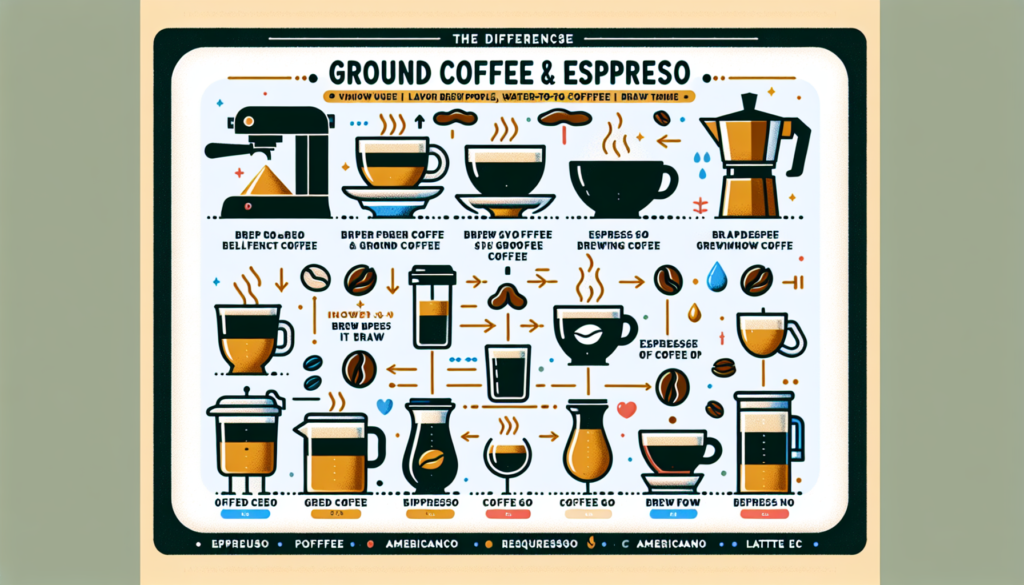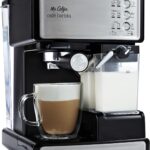So you’ve run out of espresso grounds and you’re wondering if you can just use regular ground coffee instead. Well, the short answer is yes, you can use ground coffee as a substitute for espresso, but the taste and quality may not be quite the same. In this article, we’ll explore the differences between espresso and coffee grounds, how to use ground coffee for espresso-like drinks, and some tips for achieving the best possible results. Whether you’re in a pinch or just curious, let’s find out if your morning coffee routine can survive without the trusty espresso grounds.

What Is Espresso?
Espresso is a small and concentrated coffee beverage that carries a rich and intense flavor. It is made by forcing hot water through finely ground coffee, resulting in a concentrated shot of coffee goodness. Espresso is the base for many popular coffee beverages, such as cappuccinos and lattes, and is renowned for its strong taste and aroma.
Definition
Espresso, by definition, is a method of brewing coffee that utilizes high pressure to extract flavor from coffee grounds. This brewing process results in a highly concentrated shot of coffee, typically served in small quantities. The high pressure forces the water to extract the oils and flavors from the coffee grounds, producing a more intense and flavorful cup of coffee compared to other brewing methods.
How It’s Made
To make espresso, you will need an espresso machine. The process starts by grinding coffee beans finely, ensuring a consistent and even grind size. The ground coffee is then packed into a portafilter and tamped down to create a compact and level surface. The portafilter is attached to the espresso machine, and hot water is forced through the coffee at high pressure. The water extracts the flavors and oils from the coffee, resulting in a concentrated shot of espresso.
Differences Between Espresso and Ground Coffee
While espresso is technically a form of coffee, there are several key differences between espresso and regular ground coffee.
Grind Size
One significant difference between espresso and ground coffee is the grind size. For espresso, the coffee beans are ground extremely fine, almost resembling powdered sugar. This fine grind size allows for optimal extraction when the water is forced through it under high pressure. Ground coffee, on the other hand, is typically coarser to accommodate various brewing methods, such as drip coffee makers or French presses.
Roast Level
Another difference between the two lies in the roast level of the coffee beans. Espresso beans are often roasted darker to bring out their full-bodied flavor and create a more robust taste. Ground coffee, on the other hand, encompasses a wide range of roast levels, from light to dark, catering to different taste preferences and brewing techniques.
Brewing Method
The brewing method itself is perhaps the most significant difference between espresso and ground coffee. Espresso utilizes high pressure to extract flavors from coffee grounds, resulting in a concentrated and intense shot of coffee. Ground coffee, on the other hand, can be brewed using various methods, such as drip brewing, pour-over, French press, or even cold brew. Each method produces a different flavor profile and strength.
Using Ground Coffee for Espresso
While using ground coffee instead of espresso is not the traditional method, it is still possible to achieve an espresso-like experience with certain brewing methods.
Espresso Machines
Many espresso machines are specifically designed to work best with finely ground coffee. However, they often come with built-in grinders to ensure the appropriate grind size. If you do not have a grinder, you can still use pre-ground coffee with these machines. Simply adjust the machine settings to a finer grind size and proceed with the brewing process as you would with espresso.
Moka Pot
A Moka pot, also known as a stovetop espresso maker, can also be used to brew a strong and concentrated coffee similar to espresso. These pots work by forcing hot water through ground coffee under pressure, resulting in a bold and flavorful cup. While the end result may not be identical to traditional espresso, it can still provide a strong and intense coffee experience.
French Press
While a French press is traditionally used to brew coffee with a coarser grind, it is possible to experiment with finer grounds to achieve a stronger and more concentrated brew. By using a finer grind size and adjusting the brewing time, you can mimic some of the characteristics of espresso using a French press. However, it is important to note that the flavor profile may still differ from a true espresso shot.
Adjusting the Brewing Process
When using ground coffee for an espresso-like experience, it is crucial to make adjustments in various aspects of the brewing process to achieve the desired taste and strength.
Grind Size
To mimic the fine grind size required for espresso, you can experiment with adjusting the grind setting on your grinder. Aim for a finer grind than you would typically use for other brewing methods, but avoid going too fine to prevent over-extraction and a bitter taste.
Coffee to Water Ratio
A vital factor in brewing any coffee is the ratio of coffee to water. For a stronger and more concentrated result, increase the amount of coffee relative to the water. This adjustment will enhance the flavor and intensity of the brewed coffee, closely resembling the characteristics of espresso.
Brewing Time
The brewing time also plays a role in the flavor profile of the final cup. To achieve a stronger taste, you can alter the brewing time by letting the coffee steep for a longer duration. Again, experimentation is key to finding the perfect balance and achieving a desirable espresso-like experience using ground coffee.

Taste Differences
While using ground coffee for an espresso-like experience can result in a strong and concentrated cup of coffee, there are some noticeable taste differences compared to traditional espresso.
Intensity
Espresso, made with finely ground coffee and high-pressure extraction, tends to have a stronger and more intense taste. Using ground coffee with alternative brewing methods may produce a similar strength, but it may lack some of the complexity and depth found in traditional espresso. The flavors may also be slightly different, influenced by the grind size, brewing time, and brewing method used.
Flavor
The flavor profile of espresso is often characterized by its boldness and richness. When using ground coffee, especially with alternative brewing methods, the flavor profile can vary. It may have a more pronounced acidity or a different balance of flavors compared to a shot of espresso. However, with proper adjustments and experimentation, you can still achieve a flavorful and enjoyable cup of coffee reminiscent of espresso.
Potential Challenges
Using ground coffee instead of espresso does come with a few potential challenges that are worth considering.
Equipment Limitations
While some brewing methods can produce an espresso-like experience with ground coffee, they may not achieve the exact same results as dedicated espresso machines. The high pressure generated by espresso machines is crucial for extracting the full flavors and oils from the finely ground coffee. Alternative methods may not possess the same level of pressure, leading to differences in taste and overall quality.
Consistency
Consistency can also be a challenge when using ground coffee for espresso-like brews. Achieving the perfect grind size, coffee to water ratio, and brewing time consistently can be more challenging without the specialized equipment and precision offered by espresso machines. It may require experimentation and adjustment with each brew to find the right balance and maintain consistency in taste and quality.
Tips for Using Ground Coffee as Espresso
If you’re determined to use ground coffee for an espresso-like experience, consider these tips to enhance your brewing process:
Choosing the Right Ground Coffee
Selecting the right ground coffee is essential for achieving a flavorful cup. Opt for a coffee that is specifically labeled for espresso brewing or one that offers a rich and robust flavor profile. Experiment with different roast levels and brands to find the one that best suits your taste preferences.
Experimenting with Variables
The brewing process allows for experimentation with various variables to achieve the desired taste. Adjust the grind size, coffee to water ratio, and brewing time to find the sweet spot that delivers a strong and flavorful cup of coffee. Keep a record of the adjustments made for each brew to replicate successful results in the future.
Conclusion
While espresso is traditionally made using finely ground coffee and specialized equipment, using ground coffee for an espresso-like experience is still possible with some adjustment and experimentation. By understanding the differences between espresso and ground coffee, and making necessary changes in grind size, brewing time, and other variables, you can achieve a strong and concentrated cup of coffee reminiscent of espresso. While it may not be a perfect replica of traditional espresso, it allows for more flexibility and creativity in brewing methods. So go ahead, grab your favorite bag of ground coffee, and explore the world of espresso-like brews from the comfort of your home.






